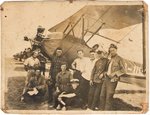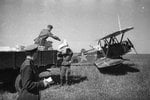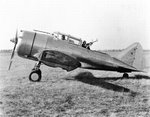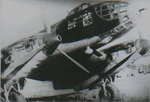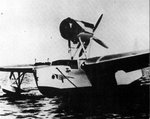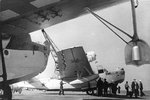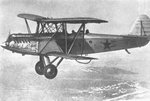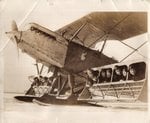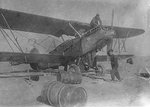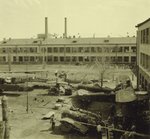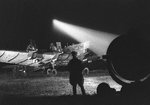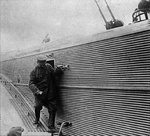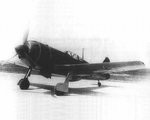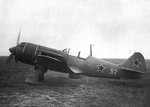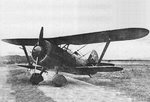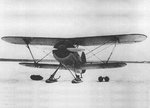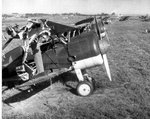At first, the Soviet Union found itself out of the war, shielded by a non-aggression pact made between Hitler and Stalin, and then in the thick of it when Germany opted to ignore the agreement and attack Russia, on June 22, 1941. (The Soviet Union did not declare war on Japan until six days before Japan surrendered.) The role of air power in Russia was difficult to determine: the areas involved were too vast to permit either side to claim air superiority, and the weather often made the entire issue moot, as the war was sometimes fought strictly on the ground and by artillery. Aviation had developed in Russia along active and parallel lines to its development in Europe and in America. The father of Russian aviation, Nikolai Zhukovsky, had established a wind tunnel research station in Moscow in 1914, beginning a deep tradition of aeronautical research in Russia. The designer who became the most prolific in the years following World War I was Andrei Nikolaevich Tupolev. It was in a Tupolev plane, the ANT-25, that three Russian fliers made their 1937 nonstop flight from Moscow to California over the North Pole, a flight of 6,750 miles (10,861km) completed in sixty-two hours and seventeen minutes. Tupolev continued the Russian fascination for large aircraft begun by Sikorsky and his IIya Mouremetz, and eventually built the Maxim Gorky and the ANT- 25bis. Meanwhile, the Soviets realized that its air force would have to include fighters as well. This effort was led by Nikolai Polikarpov, who was to design many of the best Russian fighters through World War II. The two men who developed the pilot corps of the Red Air Force were Yakov Smushkevich, who coordinated the Soviet air activities during the Spanish Civil War, and General Alexander Novikov, commander of the Soviet Air Force during World War II. The planes that the Soviets deployed in the war formed the foundation of the air force that afterward would vie with the Western powers for superiority in the sky.
The plane that became the cornerstone of the Russian air campaign was the Ilyushin IL-2m-3 Shturmovik, a two-man fighter-bomber dive-bomber with a powerful 1,770-horse- power engine and armour to withstand scores of direct hits. The Shturmovik was known as the "Flying Tank," and the Soviets built and deployed an incredible thirty-six thousand of them during the war. Its two cannons and two machine guns, combined with a bomb-load capacity of 1,320 pounds (660kg), made it a powerful weapon and support for ground troops. The only Soviet bomber of consequence in the war was the Petlyakov PE-8, a bomber with a range adequate for targets inside Germany. In the category of fighters, the Soviet Air force relied on four planes, each with strengths and weaknesses that Russian fliers came to know intimately. The first was an American plane: the Bell P-39 Airacobra, five thousand of which were given to the Soviets when the plane was spurned by American pilots.The Russians used it as a low-altitude fighter and for ground support; fitting it with a more powerful cannon made it an effective antitank weapon. The Mikoyan-Gurevich MiG-3 was a fighter with poor manoeuvrability and meagre armament, yet it proved an irritant to German planes because it climbed and dove as no other fighter. A Messerschmitt could, if not alert, suddenly find itself being swooped down on from above by a MiG-3 that cruised at forty thousand feet (12,192m) waiting for the perfect opportunity to strike. The need for a fighter that could engage the Luftwaffe at close range was met by the Yakovlev YAK-3, introduced in 1943 and comparable in performance to the Spitfire.
The YAK-3 neutralized the German fighter and Stuka attacks, and that was all that was necessary, given that Germany did not have a long-range bomber program to speak of. The most advanced Soviet fighter produced during the war was the powerfully elegant Lavochkin LA-7, a fighter introduced in 1944 that was superior to anything the Luftwaffe flew; with fifteen thousand produced, the LA-7 gave the Soviets the edge in a theatre Germany believed it dominated right to the end. The long tradition of flying in Russia, coupled with its continuing awareness that it would likely be involved in wars from both the east and the west, resulted in a strong corps of aviators, and thus of war aces. The Red Air Force's top ace was Ivan Kozhedub, with sixty-two kills in a Lavochkin fighter purchased for him by private donations.
Many other pilots endured great tests during the sieges of Russian cities and there were aces duly decorated, but no tale compares to that of Alexei Maresyev. With nineteen kills to his credit already, Maresyev crash-landed behind enemy lines and in the process crushed both his legs. He dragged himself through the snow, surviving on berries and ants, until he was rescued nineteen days later. Both his legs had to be amputated, but within a year, walking on artificial legs, he returned to service and scored seven more victories. Women pilots found their greatest acceptance in the Red Air Force, partly out of egalitarian ideology and partly because the one thousand women who volunteered were excellent pilots. An impressive thirty Citations of Hero of the Soviet Union went to women pilots, twenty- three to members of the 588th Night Bomber Regiment— the so-called Night Witches, who flew whatever planes they could find (even if they were slow P0-2 biplanes) to bomb the enemy. Three entire regiments of the Air Force were made up entirely of women, and some became legendary combat pilots. The most famous of them was Lilya Litvyak, known as the "White Rose of Stalingrad," a pilot with twenty-two kills to her credit before she was shot down. Other women whose exploits were hailed both in Russia and throughout the world were Anna Yegorova, one of the most proficient Shturmovik pilots (previously thought to be too difficult a plane for a woman to fly); Natalya Meklin, a teenage member of the Night Witches who flew 840 missions in less than three years; Valeria Khomyakova, a member of the 566th Fighter Regiment who became famous for being the first woman to down a German bomber, a JU88, in 1942; and Olga Yamschikova, the top woman ace of the war with seventeen kills, who volunteered for combat after serving as a flight instructor preparing many men to fly fighter aircraft.
Source: Soviet Air Force
The plane that became the cornerstone of the Russian air campaign was the Ilyushin IL-2m-3 Shturmovik, a two-man fighter-bomber dive-bomber with a powerful 1,770-horse- power engine and armour to withstand scores of direct hits. The Shturmovik was known as the "Flying Tank," and the Soviets built and deployed an incredible thirty-six thousand of them during the war. Its two cannons and two machine guns, combined with a bomb-load capacity of 1,320 pounds (660kg), made it a powerful weapon and support for ground troops. The only Soviet bomber of consequence in the war was the Petlyakov PE-8, a bomber with a range adequate for targets inside Germany. In the category of fighters, the Soviet Air force relied on four planes, each with strengths and weaknesses that Russian fliers came to know intimately. The first was an American plane: the Bell P-39 Airacobra, five thousand of which were given to the Soviets when the plane was spurned by American pilots.The Russians used it as a low-altitude fighter and for ground support; fitting it with a more powerful cannon made it an effective antitank weapon. The Mikoyan-Gurevich MiG-3 was a fighter with poor manoeuvrability and meagre armament, yet it proved an irritant to German planes because it climbed and dove as no other fighter. A Messerschmitt could, if not alert, suddenly find itself being swooped down on from above by a MiG-3 that cruised at forty thousand feet (12,192m) waiting for the perfect opportunity to strike. The need for a fighter that could engage the Luftwaffe at close range was met by the Yakovlev YAK-3, introduced in 1943 and comparable in performance to the Spitfire.
The YAK-3 neutralized the German fighter and Stuka attacks, and that was all that was necessary, given that Germany did not have a long-range bomber program to speak of. The most advanced Soviet fighter produced during the war was the powerfully elegant Lavochkin LA-7, a fighter introduced in 1944 that was superior to anything the Luftwaffe flew; with fifteen thousand produced, the LA-7 gave the Soviets the edge in a theatre Germany believed it dominated right to the end. The long tradition of flying in Russia, coupled with its continuing awareness that it would likely be involved in wars from both the east and the west, resulted in a strong corps of aviators, and thus of war aces. The Red Air Force's top ace was Ivan Kozhedub, with sixty-two kills in a Lavochkin fighter purchased for him by private donations.
Many other pilots endured great tests during the sieges of Russian cities and there were aces duly decorated, but no tale compares to that of Alexei Maresyev. With nineteen kills to his credit already, Maresyev crash-landed behind enemy lines and in the process crushed both his legs. He dragged himself through the snow, surviving on berries and ants, until he was rescued nineteen days later. Both his legs had to be amputated, but within a year, walking on artificial legs, he returned to service and scored seven more victories. Women pilots found their greatest acceptance in the Red Air Force, partly out of egalitarian ideology and partly because the one thousand women who volunteered were excellent pilots. An impressive thirty Citations of Hero of the Soviet Union went to women pilots, twenty- three to members of the 588th Night Bomber Regiment— the so-called Night Witches, who flew whatever planes they could find (even if they were slow P0-2 biplanes) to bomb the enemy. Three entire regiments of the Air Force were made up entirely of women, and some became legendary combat pilots. The most famous of them was Lilya Litvyak, known as the "White Rose of Stalingrad," a pilot with twenty-two kills to her credit before she was shot down. Other women whose exploits were hailed both in Russia and throughout the world were Anna Yegorova, one of the most proficient Shturmovik pilots (previously thought to be too difficult a plane for a woman to fly); Natalya Meklin, a teenage member of the Night Witches who flew 840 missions in less than three years; Valeria Khomyakova, a member of the 566th Fighter Regiment who became famous for being the first woman to down a German bomber, a JU88, in 1942; and Olga Yamschikova, the top woman ace of the war with seventeen kills, who volunteered for combat after serving as a flight instructor preparing many men to fly fighter aircraft.
Source: Soviet Air Force




